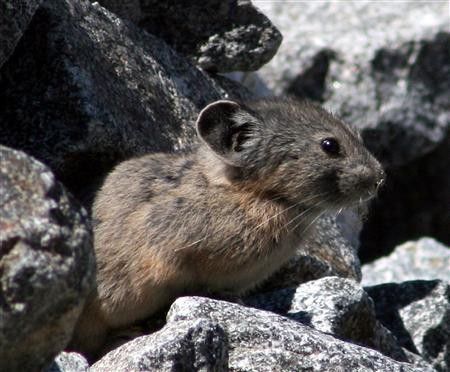Climate Change to Blame for the Decline of American Pika Population
| Marco Foronda | | Feb 04, 2015 02:38 AM EST |
(Photo : REUTERS/EARTHJUSTICE) The U.S. government has agreed to study if the American pika, a tiny cold-loving relative of the rabbit, should be protected under the Endangered Species Act.
A recent study discovers that rising temperatures seem to be driving some American pika populations extinct in low elevation sites in the Sierra Nevada.
Resembling a mouse, a pika (called a coney in the U.S.) is a small mammal with short limbs, rounded ears and no external tail. It lives in cold climates in the U.S., Asia and Europe.
Like Us on Facebook
Researchers examined 67 locations known to host pika populations and found the animals have disappeared from 10 of them, or 15 percent of the locations studied. According to Joseph Stewart, a graduate student at UC Santa Cruz and first author of the paper, pika populations are most likely to become locally extinct at sites with a small habitat area and high summer temperatures.
"This same pattern of extinctions at sites with high summer temperatures has also been observed in the Great Basin region. Backpackers and hikers often see pikas scurrying back and forth across the rocks, gathering little bouquets of wildflowers in their mouths. They are uniquely adapted to cold temperatures, but these same adaptations make the species vulnerable to global warming," he explained.
The pikas try to avoid overheating during summer and thus, spend more time underground. They spend less time foraging and gathering food for the winter, which increases the likelihood of local extinction. It also could mean trouble for other local wildlife. Pikas are an important food source for animals such as owls and stoats.
Pikas have thick fur, even inside their ears and on the bottoms of their feet. They're adapted to the cold temperatures in high-elevation boulder fields and alpine meadows.
They don't hibernate and need to maintain a high body temperature to survive the winter, which they prepare for by spending the summer harvesting grasses.
Rising temperatures also threaten the tiny animals by altering the types of plants in already shrinking alpine meadows and melting snowpacks that insulate their burrows.
According to the National Park Service, three pika communities near Crater Lake in Oregon have vanished in recent decades.
The Center for Biological Diversity has been petitioning government to put pika on the endangered species list since 2007 but hasn't been successful.
Tagsclimate change. pika, American pika, animal extinction, mammalian extinction, global warming
©2015 Chinatopix All rights reserved. Do not reproduce without permission
EDITOR'S PICKS
-

Did the Trump administration just announce plans for a trade war with ‘hostile’ China and Russia?
-

US Senate passes Taiwan travel bill slammed by China
-

As Yan Sihong’s family grieves, here are other Chinese students who went missing abroad. Some have never been found
-

Beijing blasts Western critics who ‘smear China’ with the term sharp power
-

China Envoy Seeks to Defuse Tensions With U.S. as a Trade War Brews
-

Singapore's Deputy PM Provides Bitcoin Vote of Confidence Amid China's Blanket Bans
-

China warns investors over risks in overseas virtual currency trading
-

Chinese government most trustworthy: survey
-

Kashima Antlers On Course For Back-To-Back Titles
MOST POPULAR
LATEST NEWS
Zhou Yongkang: China's Former Security Chief Sentenced to Life in Prison

China's former Chief of the Ministry of Public Security, Zhou Yongkang, has been given a life sentence after he was found guilty of abusing his office, bribery and deliberately ... Full Article
TRENDING STORY

China Pork Prices Expected to Stabilize As The Supplies Recover

Elephone P9000 Smartphone is now on Sale on Amazon India

There's a Big Chance Cliffhangers Won't Still Be Resolved When Grey's Anatomy Season 13 Returns

Supreme Court Ruled on Samsung vs Apple Dispute for Patent Infringement

Microsoft Surface Pro 5 Rumors and Release Date: What is the Latest?










